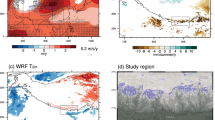Abstract
Thickness of dry convection above various deserts of the world is obtained from aerological data, and assimilated data from ECMWF. A mixed layer develops up to a height of about 1 km above the central Sahara, where strong subsidence occurs. However, above many other deserts in Africa and Asia, a deep mixed layer develops up to 4–6 km. These mixed layers develop to a high altitude because the daytime mixed layer links with an existing weakly stratified, near-neutral layer above. Large-scale subsidence does not reach the surface throughout the day, except in the winter season. Mixed-layer height is shallower in the Southern Hemisphere than in the Northern Hemisphere in the summer season.
Similar content being viewed by others
References
Carlson, T. N. and Benjamin, S. G.: 1980, ‘Radiative Heating Rates for Saharan Dust’, J. Atmos. Sci. 37, 193–213.
Charney, J. G.: 1975, ‘Dynamics of Deserts and Drought in the Sahel’, Quart. J. Roy. Meteorol. Soc. 101, 193–202.
EDC-NESDIS: 1992, ‘Monthly Global Vegetation Index from Gallo Bi-Weekly Experimental Calibrated GVI (April 1985–December 1990)’. Digital Raster Data on a 10-minute Geographic (lat/long) 1080 × 2160 grid. In: Global Ecosystems Database. Version 1.0: Disc A.: NOAA National Geophysical Data Center, Boulder, CO, USA.
Gamo, M.: 1986, ‘Seasonal Change of the Mixed Layer Structure at Tsukuba’, J. Meteorol. Soc. Japan 63, 60–74.
Gamo, M., Hayashi, H., Tamagawa, I., and Mitsuta, Y.: 1993, ‘Seasonal Variation of the Mixed Layer Characteristics in the Heife Area’, Proceedings of International Symposium on HEIFE, Disaster Prevention Research Institute, Kyoto University, pp. 316–321.
Gamo, M., Goyal, P., Kumari, M., Mohanty, U. C., and Shigh, M. P.: 1994, ‘Mixed-Layer Characteristics as Related to the Monsoon Climate of New Delhi, India’, Boundary-Layer Meteorol. 67, 213–227.
Flohn, H.: 1964, ‘Investigation On the Tropical Easterly Jet’, Bonner Meteoml Abhandlungen 4, 1–83.
Hashiguchi, H., Fukao, S., Tsuda, T., and Yamanaka, M. D.: ‘Observations of the Planetary Boundary Layer Over Equatorial Indonesia With an L Band Clear-air Doppler Radar: Initial Results’, Radio Science 30, 1043–1054.
Kato, K., Iwasaki, H., and Matsumoto, J.: 1992, ‘A Preliminary Report On the Water Cycle Around the Arid and Semiarid Area in East Asia’, Tenki 39, 408–413.
Murakami, T.: 1993, ‘Annual Mean Equatorial East-West Circulation’, Tenki, 40, 681–690.
Taguchi, S. and Taylor, J.: 1994, ‘A Simulation of Methane and Methyl Chloroform Using the NIRE Global Three-Dimensional Tracer Transport Model’, Proceedings of the International symposium on global cycles of atmospheric greenhouse gases, pp. 319–332.
Author information
Authors and Affiliations
Rights and permissions
About this article
Cite this article
Gamo, M. Thickness of the dry convection and large-scale subsidence above deserts. Boundary-Layer Meteorol 79, 265–278 (1996). https://doi.org/10.1007/BF00119441
Accepted:
Issue Date:
DOI: https://doi.org/10.1007/BF00119441




